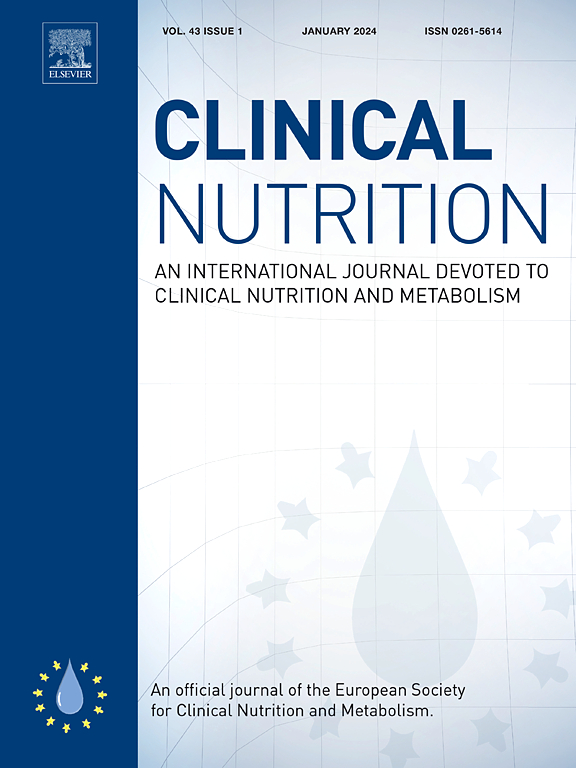Metabolic kinetics and muscle and brain health markers in older adults, and the role of age and presence of chronic morbidities: A large cross-sectional cohort study
IF 6.6
2区 医学
Q1 NUTRITION & DIETETICS
引用次数: 0
Abstract
Background & aims
Older adults are at risk for muscle and cognitive function decline during advanced aging, but the underlying metabolic mechanisms and the role of aging-associated chronic morbidities remain unclear. In the present study, we examined whether protein and amino acid kinetics in older adults with and without chronic morbidities are different when 50–70 and 70–90 of age and related to markers of muscle and brain health declines.
Methods
In a large cross-sectional observational study, 575 older adults from 12 trials (2014–2022) were stratified based on their age (50-70y vs. 70-95y) and the presence of chronic morbidities. The main outcomes were whole-body production (WBP) and interconversions of amino acids by stable amino acid tracers, body composition, and muscle and cognitive performance. Additionally, the association between metabolic markers and muscle and brain health was assessed.
Results
Overall lower muscle strength, muscle and fat mass, and cognitive function (p < 0.03), but no mood disturbances, were found in 70–95y compared to 50-70y older adults. Presence of morbidities was associated with lower muscle strength and mass, and cognitive function, but higher visceral adipose tissue, and mood disturbances (p < 0.05). Aging was associated with suppressed WBP of most amino acids, de novo arginine production, and net protein breakdown, but higher myofibrillar protein breakdown (p < 0.007). Presence of morbidities was associated with lower WBP of glutamine, glutamate, histidine, isoleucine, phenylalanine, tyrosine, and net protein breakdown, and higher WBP of valine and taurine (p < 0.04). Age showed significant negative correlations with WBP of nearly all amino acids, de novo arginine production and net protein breakdown (r: [-0.407, −0.136], p < 0.01) but a positive correlation with WBP of myofibrillar protein breakdown (r = 0.133, p = 0.009). Lean mass showed positive correlations with de novo arginine production and net protein breakdown and WBP of all amino acids except for isoleucine (r: [0.16, 0.799], p < 0.005). MoCA showed a positive correlation with WBP of leucine and valine (r: [0.163, 0.2], p < 0.03). Worse cognitive performance was positively associated with WBP of tau-methylhistidine and taurine (r: [0.13, 0.141], p < 0.04), but negatively associated with WBP of glycine and valine, de novo arginine production, and net protein breakdown (r: [-0.222, −0.115], p < 0.05).
Conclusion
Comprehensive phenotyping of a large group of older adults revealed differences in metabolic health in response to advanced aging and chronic morbidities. Poor muscle health accompanied by advanced aging was associated with overall metabolic downregulation, except for enhanced myofibrillar (muscle) protein breakdown. Presence of chronic morbidities was further associated with disturbed muscle health, mood, arginine, and taurine pathways, and higher visceral adipose tissue. Therefore, different phenotypes among older adults need to be considered when evaluating therapeutic approaches to improve muscle and brain health.
老年人的代谢动力学、肌肉和大脑健康指标,以及年龄和是否患有慢性疾病的作用:大型横断面队列研究
背景& 目的老年人在晚期衰老过程中面临肌肉和认知功能衰退的风险,但其潜在的代谢机制以及衰老相关慢性疾病的作用仍不清楚。在本研究中,我们考察了有慢性病和无慢性病的老年人在 50-70 岁和 70-90 岁时的蛋白质和氨基酸动力学是否不同,以及与肌肉和大脑健康衰退标志物的关系。方法在一项大型横断面观察性研究中,根据年龄(50-70 岁 vs. 70-95岁)和是否有慢性病对来自 12 项试验(2014-2022 年)的 575 名老年人进行了分层。研究的主要结果是全身氨基酸产生量(WBP)和稳定氨基酸示踪剂的氨基酸相互转化率、身体成分以及肌肉和认知能力。结果发现,与 50-70 岁的老年人相比,70-95 岁的老年人肌肉力量、肌肉和脂肪质量以及认知功能总体较低(p < 0.03),但没有情绪障碍。患有疾病的老年人肌肉力量和质量以及认知功能较低,但内脏脂肪组织和情绪障碍较高(p <0.05)。衰老与大多数氨基酸的WBP、新精氨酸生成和净蛋白质分解受到抑制有关,但与肌纤维蛋白质分解增加有关(p <0.007)。患病与谷氨酰胺、谷氨酸、组氨酸、异亮氨酸、苯丙氨酸、酪氨酸和净蛋白质分解的 WBP 值降低,以及缬氨酸和牛磺酸的 WBP 值升高有关(p <0.04)。年龄与几乎所有氨基酸、从头生成精氨酸和净蛋白质分解的 WBP 呈明显负相关(r:[-0.407,-0.136],p <;0.01),但与肌纤维蛋白质分解的 WBP 呈正相关(r = 0.133,p = 0.009)。瘦体重与从头生成精氨酸和净蛋白质分解以及除异亮氨酸外所有氨基酸的 WBP 呈正相关(r:[0.16, 0.799],p < 0.005)。MoCA 与亮氨酸和缬氨酸的 WBP 呈正相关(r:[0.163, 0.2],p < 0.03)。认知表现较差与 tau-methylhistidine 和牛磺酸的 WBP 呈正相关(r:[0.13, 0.141],p <;0.04),但与甘氨酸和缬氨酸的 WBP、从头生成精氨酸以及蛋白质净分解呈负相关(r:[-0.222, -0.115],p <;0.05)。除了肌纤维(肌肉)蛋白质分解增加外,伴随着高龄化的肌肉健康状况不佳与整体代谢下调有关。慢性疾病的存在还与肌肉健康、情绪、精氨酸和牛磺酸途径的紊乱以及内脏脂肪组织的增加有关。因此,在评估改善肌肉和大脑健康的治疗方法时,需要考虑老年人的不同表型。
本文章由计算机程序翻译,如有差异,请以英文原文为准。
求助全文
约1分钟内获得全文
求助全文
来源期刊

Clinical nutrition
医学-营养学
CiteScore
14.10
自引率
6.30%
发文量
356
审稿时长
28 days
期刊介绍:
Clinical Nutrition, the official journal of ESPEN, The European Society for Clinical Nutrition and Metabolism, is an international journal providing essential scientific information on nutritional and metabolic care and the relationship between nutrition and disease both in the setting of basic science and clinical practice. Published bi-monthly, each issue combines original articles and reviews providing an invaluable reference for any specialist concerned with these fields.
 求助内容:
求助内容: 应助结果提醒方式:
应助结果提醒方式:


